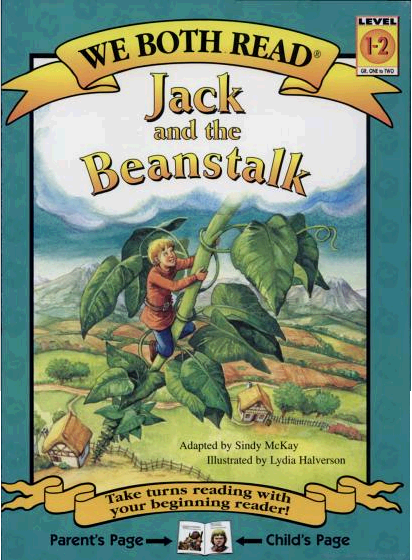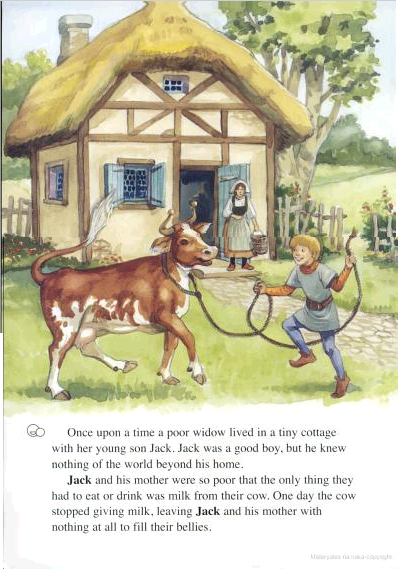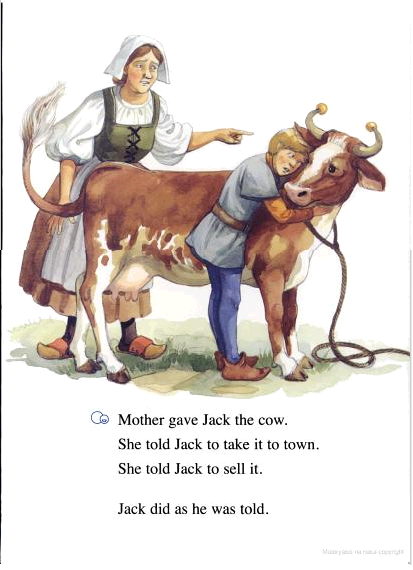Introduction
Speaking and listening is an integral part of learning and thinking (Brace, Brockhoff, Sparkes, & Tuckey, 2006, p.2). Teachers must know how to develop appropriate strategies that incorporate the principles of field, tenor, and mode (Flynn, 2004). Teachers must learn to understand the different phases in speaking and listening such as the beginning phase; early phase; exploratory phase; consolidating phase; and conventional phase. An effective teacher in this field must know how to incorporate all the principles learned in the First Steps Speaking and Listening Map of Development framework when creating a speaking and listening learning activity.
The Text & First Steps
The first thing that has to be done is to choose the reading material. The material that was used came from a favorite children’s story entitled Jack and the Beanstalk. The material was chosen because the publisher and the author made a deliberate attempt to tailor-made the story to cater to children that are in Grade One and Grade Two. The classification can be seen in the front cover of the said book where it says Level 1-2.
A close examination of the book will reveal that it was created to encourage both teacher and student to read the story. The first page and the introductory portion of the story are tailor-made for the adult reader. This can be seen in the use of more complicated sentences and terminologies such as: “One day the cow stopped giving milk, leaving Jack and his mother nothing at all to fill their bellies” (McKay, 1998, p.1).
However, after reading the first page of the book, the teacher allows the child to read because this time around the sentences are much simpler and the vocabulary used is appropriate for a seven or eight-year-old child. Consider the following example: “Jack did as he was told” (McKay, 1998, p.2). It is now easier to understand the meaning of the banner that says “We both read” (McKay, 1998). The book was developed to make it easier for teachers and students to take turns reading.
The First Steps Speaking and Listening Phase for which this text is appropriate would be the Exploratory Phase. The back and forth format where the adult reads part of the story and then gives way for the participation of the children is a good example of the exploratory phase when using the text for the speaking and listening exercise. Furthermore, the use of this particular text provides opportunities for the small group of children to participate in authentic unplanned and planned speaking and listening exercises.
Reading Aloud
The children appreciated the fact that I tried my best to provide appropriate facial and vocal expressions to make the story interesting. I realized that the story must be interesting before the children can be drawn in to participate. Nevertheless, ignorance of the importance of pace, as well as facial and vocal expressions, can easily render a wonderful story into a boring interaction. Children at this age can already appreciate the language and their imagination can help them appreciate a good story. A skilled storyteller can enhance the value of the story and can sustain the interest of the listener throughout the listening and speaking exercise.
The format of the text wherein adults and children can both read the story is an effective technique in teaching the importance of speaking and listening as communication tools. The participants understood that their ability to read and speak the words is greatly appreciated because an adult allowed them to read aloud, speak the words and while they are doing it I was listening to them intently. Thus, they can learn not only to speak but also to listen. The taking of turns is also an effective tool when it comes to dealing with distractions in the environment. If they see something interesting in the area their attention can be easily diverted to that object or action. But when they know that they need to take turns reading the story it seems that their attention is riveted to the book and the teacher.
I also realized that if the children are allowed to participate by reading parts of the story then it is easier for them to remember a significant portion of the text. When I asked one of the participants I was surprised that she can retell the story from memory. Interestingly, she can provide significant details about the story especially when it comes to the sections wherein she was given the chance to read that particular portion of the book. It seems that it is easier for them to remember the story in this manner as compared to when they are passive listeners.
Lesson Plan
Speaking and listening are an integral part of communication but most of the time children and adults are not aware of the relationship and impact of these two. Thus, teachers need to identify these two different skills. This learning exercise demonstrates that these skills can be learned and taught. It is only important to learn how to identify and develop exercises that will pinpoint listening and speaking skills. The following lesson plan helps guide the development of the activity.
- Name of Student: Carmela Jones
- School Year/Age: 7 years old; First Grade
- Name of Student: Michelle Copeland
- School Year/Age: 7 years old; First Grade
- Name of Student: Karla Webb
- School Year/Age: 7 years old; First Grade
The procedure of Individual/small group learning experience
Transcription
Analysis of Activity
It is imperative to learn how to identify and develop exercises that will enhance listening and speaking skills. In this particular activity, one can find numerous examples of planned and unplanned speech. Planned speech usually came from the teacher and unplanned speech usually came from the students. The planned speech enables the teacher to provide examples that covered the following areas: a) field; b) tenor; and c) mode (Butler, 1999). In other words, planned speech helps guide the learning process. The unplanned speech of the students provides feedback with regards to the impact of the learning process.
An example of a planned speech can be seen in Line 1 of the Transcription, the teacher announced to the group that she is going to tell the story of Jack and the Beanstalk. By doing so she has established the field of the exercise by presenting the subject matter. It also provides a limitation on the topic that can be discussed in that particular activity. This technique implies that the learner can focus on a particular subject matter. The response was an unplanned speech as can be seen in Line 2. However, the response of the student allows the teacher to determine if they are familiar with the story and if they can interact using this material.
Another example of a planned speech can be seen in Line 3. In this example, the teacher explained how the story will be told. The teacher established the tenor by demonstrating that the teacher and students must take turns reading the story (Danesi, 2003). The tenor helps establish the relationship between the teacher and student in a particular learning activity. The response of a student in Line 4 is proof that the students immediately grasped the expected relationship and the manner of interaction between teachers and students.
Another example of an unplanned speech can be found in Line 5. Through this statement, the teacher established the mode by designing an activity that allowed the children to retell the story using puppets. The response is an example of an unplanned speech but it signals the teacher that the students are aware of the field and tenor. Also, the response of the student-created feedback that the language produced can be based on the material and even outside of it. When the field, tenor, and mode were established the students were able to provide an example of a planned speech.
Reflection
The activity that was based on the First Steps Speaking and Listening made me realize that to significantly improve listening and speaking skills, teachers must develop appropriate learning activities. In this case, the most critical component of the activity is the use of the book that enables teachers and students to interact in a non-conventional way. In the past, teachers dominate the classroom and they made it difficult for students to interact. But in this particular activity, the students were able to participate. More importantly, they learn to listen to their teachers and with each other.
I am also impressed by the deliberate creation of a material that considered the year level of the readers. I am also impressed by the fact that the format was designed in such a way that the teacher and students can interact with each other. The most effective feature in the reading material is the way the teacher can initiate the speaking and listening process and yet at the same time allow the students to participate using easy to read sentences.
It is also important to point out the need to consider other aspects of listening and speaking activity. The participants can be easily distracted. In any given activity it is easy for them to be distracted from the various stimuli present in the environment. Thus, the use of the book and the puppets provided an insight into how to limit the impact of these distractions. It must be pointed out that when the students are told that they take turns reading, then, there is heightened anticipation and therefore they can easily focus on the task at hand.
Another significant learning experience from the said activity is the effectiveness of the reading material and the use of puppets when it comes to teaching the children how to listen to other people. By taking turns they know that everyone will get the chance to read and speak. These are important considerations in the process of teaching children to speak and listen effectively.
I also realized the magnitude of establishing field, tenor, and mode. It is significant to establish the field of learning exercise because the students must focus on one thing. Thus, it is easier for students to determine what is expected of them. In this case, they need to read and listen to the story of Jack and the Beanstalk. The same thing can be said about the significance of tenor. The utilization of this principle can compel teachers to establish the relationship between teachers and students.
In this particular case, the teacher explained clearly that she must read first from the book to initiate the pattern of taking turns. I also realized the importance of mode. The mode is a guide that can help students and teachers alike determine how they are going to produce the text in the communication process. In this case, the model can be seen in the design of the activity that requires the use of puppets. The participants recall from memory the story of Jack and the Beanstalk. Through the use of their vocabulary, they were able to retell the story.
Conclusion
Listening and speaking are indeed an integral part of the learning process. Listening and speaking are also indispensable communication tools. The challenge is to teach children how to speak and listen more effectively. The activity allowed the teacher to develop a more efficient method of teaching first-grade students how to speak and listen. The reading material and the use of the puppets are integral components for this particular exercise. The reading material allowed them to establish the field and tenor of the learning activity while the puppets enable the teacher to establish the mode of the listening and communication process.
Appendix



References
Brace, J., Brockhoff, V., Sparkes, N., & Tuckey, J. (2006). First steps: speaking and listening map of development. AU: Rigby.
Butler, L. (1999). Registering the difference: reading literature through register. UK: Manchester University Press.
Danesi, M. (2003). Second language teaching: a view from the right side of the brain. MA: Kluwer.
Flynn, P. (2004). applying standards-based constructivism. NY: Eye on Education.
McKay, S. (1998). Jack and the Beanstalk. CA: Treasury Bay, Inc.